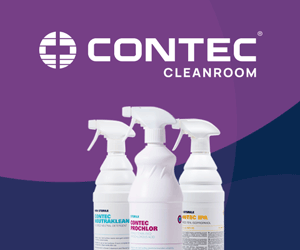Endotoxins: A critical concern for critical environments
Endotoxins can cause deadly consequences when introduced into the human body and they can also negate the validity of diagnostic tests
Endotoxins are at the forefront of critical environment contamination control. Difficult to eliminate through common means of sterilisation, such as standard autoclaving procedures, and easy to transfer even while following cleanroom protocols, endotoxins are a threat across industries. Not only can endotoxins cause deadly consequences when introduced into the human body, but they can also negate the validity of diagnostic tests.
Spread through destroying bacteria
Endotoxins are fever-inducing components of Gram-negative bacteria cell membranes. The terms endotoxins, pyrogens and lipopolysaccharides (LPS) can be confusing as they are often used synonymously.
Pyrogens are any substance that induces fevers, which includes but is not limited to endotoxins.
Lipopolysaccharides (LPS) are the primary component of Gram-negative bacteria cell membranes, representing the most common type of endotoxin. Thus, all endotoxins, including LPS, are pyrogens, but not all pyrogens are in fact endotoxins.
Endotoxins are shed in relatively small amounts by growing, living Gram-negative bacteria. But when the bacteria die, endotoxin release dramatically increases. This makes endotoxins especially dangerous. The very act of destroying Gram-negative bacteria can spread endotoxin contamination.
A threat across industries
The spread of endotoxins is a serious threat in a variety of industries. In biomedical and health diagnostics, endotoxins can cause severe complications in biological studies, interfering with experiments and causing the misinterpretation of results. In healthcare, endotoxins cause a host of serious health problems, ranging from fevers to endotoxin shock. Even in very small amounts, endotoxins can cause deadly diseases. If injected into blood, endotoxins can cause endotoxemia, which can lead to septic shock and death. Endotoxins have even been linked to far-ranging health issues such as allergies, asthma, and obesity.
Fighting endotoxins requires a multifaceted, industry- and application-driven approach to cleanroom contamination control. Standard autoclaving procedures used in laboratories do not effectively reduce endotoxin levels, and unused endotoxin-free plasticware is often recommended in place of reusable glassware. In medical manufacturing, the use of the end product determines the severity of endotoxin prohibition. Products intended for contact with cerebrospinal fluid have the most severe restrictions, being required to meet the most stringent US FDA standards for bacterial endotoxins.
Clean wiping: A baseline of endotoxin defence
But all industries concerned have a need for specialist wiping products to combat endotoxin contamination, regardless of terminal sterilisation procedures and/or aseptic practices. Important features to consider are sealed edges, double-bagged packaging, laundering, and specific high-purity and high-absorbency material types, such as polyester knit or polyester/cellulose nonwovens.
For extremely critical applications such as implantable materials, pharmaceuticals, and other applications that directly or indirectly contact cerebrospinal fluid, gamma irradiated, validated sterile wipes such as Essentra’s Ultra Low Endotoxin Critical CF Wipes are necessary. USP Chapter 161 compliance and 0.06 EU/ml limits ensure superior endotoxin concentration standards.
Ending endotoxins
Determining the appropriate endotoxin control products for specific applications and applying them through effective cleaning procedures is crucial for cleanrooms across the world.
Combating endotoxins is a core component of critical environment contamination control; utilise every tool at your disposal.




